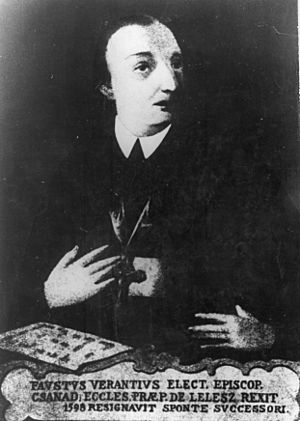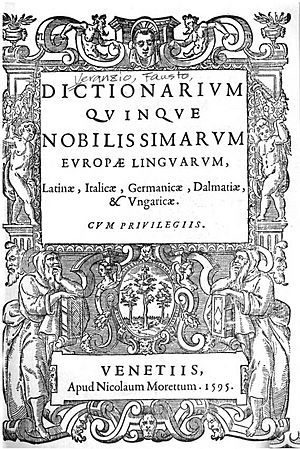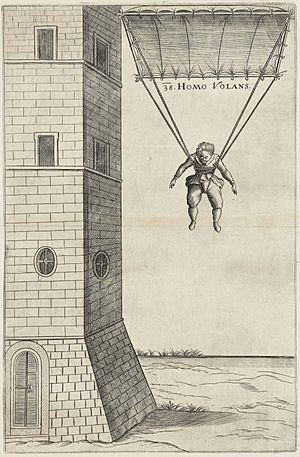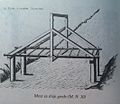Fausto Veranzio facts for kids
Quick facts for kids
Faust Vrančić
Fausto Veranzio |
|
|---|---|

Portrait of Faust Vrančić
|
|
| Born | |
| Known for | Polymath, bishop |
|
Notable work
|
Machinae Novae, Dictionarium quinque nobilissimarum Europæ linguarum |
Faust Vrančić (born around 1551 – died January 17, 1617) was an amazing person from Šibenik, a city that was part of the Venetian Republic (now in Croatia). He was known as a polymath, which means he was good at many different subjects like science, engineering, and languages. He was also a bishop, a leader in the church.
Contents
Life Story
His Family
Faust Vrančić was born into the Vrančić (Veranzio) family in Šibenik. This was a well-known family of writers and important people.
His father, Michele Veranzio, was a poet who wrote in Latin. His uncle, Antonio, was a very important person. He was an archbishop (a high-ranking church leader) and a diplomat (someone who represents their country to others). Antonio knew famous thinkers like Erasmus. He often took young Fausto with him on his travels through Hungary and the Venetian Republic.
The Vrančić family had a main home in Šibenik. They also had a large summer house on Prvić island. Faust Vrančić was later buried in a church on this island.
School and Work
When he was young, Faust Vrančić loved science. He moved to Venice for school, then went to the University of Padua in Italy. There, he studied many subjects, including law, physics, engineering, and mechanics.
Later, he worked for King Rudolf II in Prague. He was a chancellor for Hungary and Transylvania. During this time, he met famous scientists like Johannes Kepler and Tycho Brahe.
After his wife passed away, Vrančić moved to Hungary. In 1598, he became a bishop of Csanád, though he never actually visited that place. In 1609, he returned to Venice and focused on his scientific studies. Faust Vrančić died in Venice in 1617. He was buried on Prvić island, near his family's summer home.
Inventor and Thinker
Faust Vrančić's most famous book is called Machinae Novae (which means "New Machines"). It was published around 1615 or 1616. This book had 49 big pictures showing 56 different machines, devices, and technical ideas.
The book was written in Italian, Spanish, French, and German. It showed many of his inventions and designs. Vrančić wrote about using water and solar energy. He designed different types of mills and farm machines. He also drew plans for various kinds of bridges made from different materials. Some of his ideas included a machine to clear the sea, a special two-person carriage, and even a "Flying Man" (Homo Volans), which was an early idea for a parachute. He also thought of a "portable boat" that could go against a river's current. He even had an idea for a rotary printing press to make printing easier.
Machinae Novae was a very rare book because Vrančić paid to publish it himself. But it made him famous around the world. His designs were even printed in China years later!
The Parachute Idea
One of the most famous drawings in Machinae Novae is the "Flying Man" (Homo Volans). This drawing shows a design for a parachute. Vrančić had looked at Leonardo da Vinci's early sketches for a parachute.
There's a story that in 1617, when he was over 65 years old, Vrančić actually built his parachute and jumped from the St Mark's Campanile in Venice. This story was written about 30 years later by John Wilkins. However, Wilkins' book doesn't actually mention Vrančić or any jump in 1617. So, there's no real proof that Vrančić ever tested his parachute. Still, his design was a very important step in the history of parachutes!
Mills and Wind Turbines
Vrančić was very interested in engineering and mechanics, especially mills. He created 18 different designs for them. He imagined windmills with both vertical and horizontal spinning parts. He also designed different wing shapes to make them work better.
He even had an idea for a mill powered by tides. This mill would use pools that filled with water at high tide and emptied when the tide went out, using just gravity. This idea is similar to how some modern power plants work today! Faust Vrančić also described the very first designs for wind turbines in his book Machinae Novae.
Working in Rome and Venice
The Pope asked Vrančić to spend two years in Rome. There, he designed projects to control rivers, especially the Tiber, which often flooded Rome. He also worked on how to get water to Venice, a city surrounded by the sea.
Vrančić also designed ways to tell time using water, fire, or other methods. His own sun clock could tell the time, date, and month, but only in the middle of the day.
He also studied how to build metal bridges and how forces work in structures. He drew plans for suspension bridges and cable-stayed bridges more than 200 years before they were actually built! He also designed ideas for modern tied-arch bridges, through arch bridges, truss bridges, and even aerial lifts (like cable cars).
-
Drawing of suspension cable-stayed bridge by Fausto Veranzio in his Machinae Novae
Language Expert

Faust Vrančić also wrote a very important dictionary called Dictionarium quinque nobilissimarum Europæ linguarum. It was published in Venice in 1595. This dictionary had 5,000 words in five languages: Latin, Italian, German, the Dalmatian dialect of Croatian, and Hungarian. He called these the "five noblest European languages."
This dictionary was very important for the Croatian and Hungarian languages. It helped shape how these languages are written today. For example, Hungarian accepted his ideas for how to use certain letters. It was also the first dictionary for the Hungarian language. This book inspired many other dictionaries in Europe.
His Legacy
Faust Vrančić's ideas continued to influence people long after his death.
- The famous philosopher Ludwig Wittgenstein was inspired by Vrančić's Machinae Novae when he studied mechanical engineering.
- A tidal mill in New York City, built in the 17th century, was based on Vrančić's plans.
- In 1965, an astronomy society in Šibenik was named after him.
- The Croatian Parliament created the "Faust Vrančić" National Award for Technical Culture in 1992. This award honors people who have done great things in technology.
- In 2012, the Faust Vrančić Memorial Centre opened on Prvić island. Visitors can learn all about his life and see models of his amazing inventions.
- A rescue ship in the Croatian Navy and many schools and streets in Croatia are named after him.
- Every year, a cultural event called Days of Faust Vrančić is held in Šibenik.
See also
 In Spanish: Fausto Verancio para niños
In Spanish: Fausto Verancio para niños










